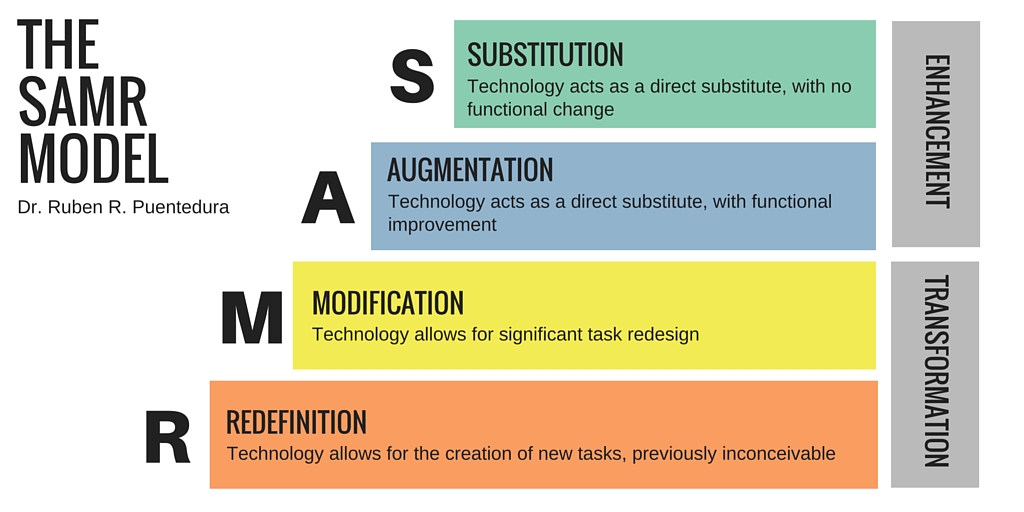Using SAMR and TPACK
Over the past few years I have been steadily increasing the use of technology in my classroom, made easier with the school introducing BYOD in the junior school. As such I have been familiar with the SAMR model:
Image source: https://upload.wikimedia.org/wikipedia/commons/5/5e/The_SAMR_Model.jpg
I won't discuss the mechanics of the model because there are plenty of people on the internet more qualified than me who have done so (check out Kathy Shrock here and the Technology is Learning site here, as starting points).
In many ways I like this model because it provides a stepping stone approach to using technology which is useful for teachers just on the first step of changing their teaching practices. It shows that introducing digital activities doesn't have to involve major shifts in practice but can be incremental. It also shows, though, that ultimately students should not be using a computer to complete the same activities that they would be doing with pen and paper. Kathy Schrock links the transformational phrase to Bloom's higher order thinking skills, and I think that this is a natural fit. To me this is a supportive model for teachers.
One of my concerns is that the emphasis, though, is still on task design and I think that this is where TPACK has the advantage. I honestly hadn't heard of this model until I checked out the resources for the third Mindlab session.
Image source: https://upload.wikimedia.org/wikipedia/commons/5/5e/The_SAMR_Model.jpg
I won't discuss the mechanics of the model because there are plenty of people on the internet more qualified than me who have done so (check out Kathy Shrock here and the Technology is Learning site here, as starting points).
In many ways I like this model because it provides a stepping stone approach to using technology which is useful for teachers just on the first step of changing their teaching practices. It shows that introducing digital activities doesn't have to involve major shifts in practice but can be incremental. It also shows, though, that ultimately students should not be using a computer to complete the same activities that they would be doing with pen and paper. Kathy Schrock links the transformational phrase to Bloom's higher order thinking skills, and I think that this is a natural fit. To me this is a supportive model for teachers.
One of my concerns is that the emphasis, though, is still on task design and I think that this is where TPACK has the advantage. I honestly hadn't heard of this model until I checked out the resources for the third Mindlab session.
Image source www.tpack.org
Again, information on the model is available elsewhere (such as the website dedicated to it). What I like about this model is that it considers all aspects of teaching highlighting where technological, content (what) and pedagogical (how) knowledges meet to improve student learning. We can start with the content needed and look at how we can present this content - then look at the technology needed as a partner to make content more accessible to students and supporting our teaching strategies. I also like that it acknowledges the importance of context. To me this feels like a more comprehensive model, focusing on aligning our use of technology to our teaching styles and the needs of the curriculum and the students in front of us, rather than emphasising how we use it.
I can also see that the two models work together - SAMR fits withing the technological knowledge strand.
Here is an activity designed by myself and others in my group as part of Mindlab session 3 - create an activity using the SAMR or TPACK model, using Google Maps, Tours or Earth, within a limited period. We utilised SAMR, creating a 'redefined' activity not possible without the use of technology. Perhaps a little predictably, we chose the Rio Olympics as the focus of our activity - I think there could be some great activities based around Syria or the EU we could also have developed. These are some great tools to make learning more 'real' for students.


Comments
Post a Comment